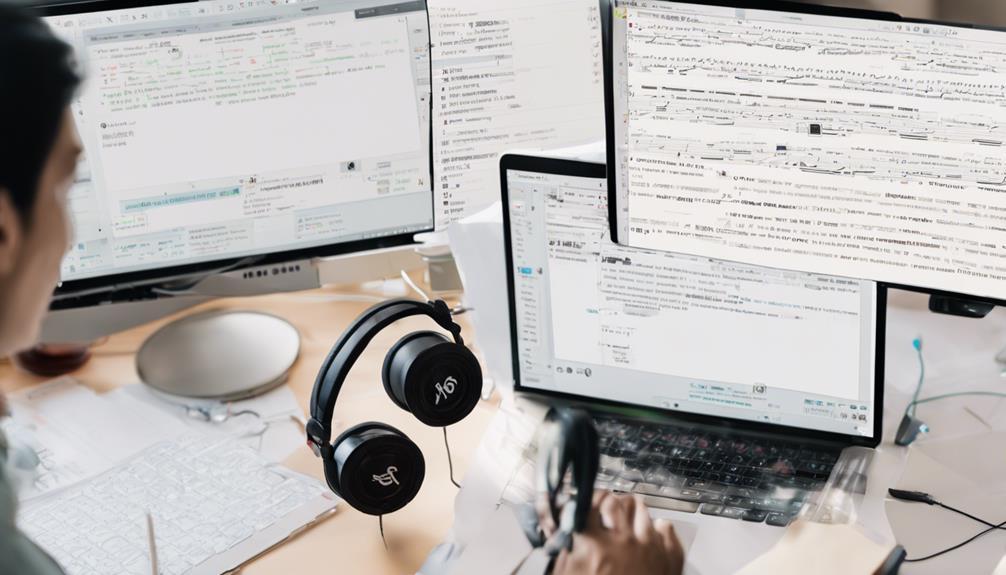If you want to transcribe Vietnamese audio to text in 2024, you’ll need to grasp the language’s tonal nuances and regional dialects. Utilizing advanced technologies like machine learning, you can access tools such as Google Cloud Speech-to-Text and bevoice.net for effective transcription. Consider whether you want manual or automated services based on your accuracy needs. Remember, dialects influence understanding, so familiarize yourself with sound variations for better results. Accessibility is key, and your choice of service should reflect that. Stick around, and you’ll uncover more tips and tools for seamless transcription success.
Key Takeaways
- Utilize advanced machine learning algorithms and real-time processing for accurate Vietnamese audio transcription in 2024.
- Choose transcription tools like Google Cloud Speech-to-Text or bevoice.net for efficient support in Vietnamese dialects.
- Prioritize manual transcription for nuanced conversations to enhance accuracy over automated methods.
- Familiarize yourself with regional dialects and idiomatic expressions to improve transcription quality.
Importance of Audio Transcription

Transcribing audio to text enhances accessibility and allows you to capture critical information more effectively. Whether you’re working on research, conducting interviews, or creating content, having a written record makes it easier to reference key points. You don’t have to struggle with listening to recordings repeatedly; a transcript provides a clear, organized format that you can quickly skim through.
Moreover, transcription is essential for inclusivity. It helps those who are hard of hearing or deaf engage with your content. By making your audio accessible, you’re broadening your audience and ensuring that everyone can benefit from your work.
Additionally, transcribing audio improves your understanding of the material. You may notice details you missed during listening, allowing for deeper insights and more informed discussions. When you need to quote or cite a source, having the text readily available saves you time and enhances accuracy.
Vietnamese Language Nuances
Understanding the nuances of the Vietnamese language is vital for accurate transcription, as it helps capture the subtleties of meaning and context that can easily be lost in translation. Vietnamese is a tonal language, meaning the pitch of a word can change its meaning. You’ll need to pay close attention to these tones to ensure you’re transcribing accurately.
Moreover, Vietnamese is rich in idiomatic expressions and regional slang. What might be common in one area can be completely different in another. Familiarizing yourself with these variations will improve both your understanding and transcription accuracy. For example, words like “bánh” can refer to various types of cakes, depending on context.
Additionally, context plays a crucial role. A word may have multiple meanings, and understanding the speaker’s intent is essential. Listening carefully to the surrounding dialogue can provide clues that guide your transcription.
Lastly, be mindful of formality levels in Vietnamese. The language has different pronouns and verb forms depending on the relationship between speakers. Recognizing these nuances will enhance the quality of your transcriptions and ensure they resonate well with native speakers.
Key Technologies in 2024

In 2024, innovative technologies are transforming the landscape of audio transcription, making it faster and more accurate than ever before. Machine learning algorithms are at the forefront, enabling systems to better understand the nuances of the Vietnamese language. These algorithms learn from vast datasets, improving their ability to recognize different accents and dialects, which is crucial for effective transcription.
You’ll also find that real-time processing capabilities have significantly enhanced. With advancements in natural language processing (NLP), audio files can be transcribed as they’re being recorded. This means you can get immediate feedback, allowing for adjustments on the fly.
Cloud computing plays a vital role too; it provides the necessary power for processing large audio files quickly and efficiently. You’ll appreciate the convenience of accessing transcription services from anywhere, as long as you have an internet connection.
Moreover, integration with other software tools has become seamless. You can now easily import audio files from various platforms, allowing for a smooth workflow. Overall, these key technologies are not just improvements; they’re game-changers in how you transcribe Vietnamese audio to text.
Top Transcription Tools
With the advancements in technology, several top transcription tools have emerged that streamline the process of converting Vietnamese audio to text. These tools cater to various needs, whether you’re a student, a professional, or a content creator.
One of the most popular tools is Google Cloud Speech-to-Text. It offers robust support for Vietnamese and utilizes machine learning to enhance accuracy. You can easily integrate it into your applications for seamless transcription.
Another excellent option is Sonix. This tool provides a user-friendly interface and supports multiple languages, including Vietnamese. It also offers features like automatic timestamps and speaker identification, making it a great choice for interviews and podcasts.
If you’re looking for something more tailored, try Temi. It’s known for its quick turnaround time and affordability. While it may not have the same accuracy as some advanced tools, it works well for straightforward tasks.
Lastly, Otter.ai is gaining traction for its collaboration features, enabling teams to work on transcripts together. These tools not only save you time but also enhance the efficiency of your transcription process. Choose the one that fits your needs and watch your productivity soar.
Manual Vs. Automated Transcription

Choosing between manual and automated transcription can significantly impact the quality and efficiency of your project. When you opt for manual transcription, a human transcriber listens to your audio and types out the text. This method often yields higher accuracy, especially for nuanced conversations or dialects, like Vietnamese. However, it can be time-consuming and more costly, as professional transcribers charge for their services.
On the other hand, automated transcription uses software to convert audio to text quickly. While it’s faster and usually cheaper, the quality may suffer, especially with background noise or heavy accents. You might find that the automated tool struggles with certain phrases or names, leading to inaccuracies in the transcription.
Ultimately, your choice depends on your project’s specific needs. If you prioritize accuracy and can afford the time and expense, manual transcription is often the way to go. However, if you need a fast turnaround and can tolerate some errors, automated options might suit you better. Consider your priorities carefully to make the best decision for your transcription needs.
Best Practices for Accuracy
Ensuring accuracy in Vietnamese audio transcription requires a careful approach that combines attentive listening and familiarity with the language’s nuances. Start by choosing a quiet environment to minimize distractions. This helps you focus on the audio and catch every detail.
Next, familiarize yourself with the speaker’s accent and style. Understanding regional dialects can significantly enhance your comprehension. If the speaker uses particular jargon or idiomatic expressions, take time to research these terms beforehand.
Use high-quality headphones to capture subtle sounds and nuances. This can make a considerable difference, especially in noisy recordings. As you transcribe, play back sections multiple times when you’re unsure. Don’t hesitate to pause, rewind, and listen again until you feel confident in your transcription.
Additionally, implement a system for proofreading your work. After completing the initial transcription, review it for errors or omissions. Reading it aloud can help you spot mistakes and ensure the text flows naturally. Finally, consider seeking feedback from native speakers to validate your work, as they can provide insights you might’ve missed. Following these best practices will bolster the accuracy and quality of your Vietnamese transcriptions.
Handling Different Dialects

When transcribing Vietnamese audio, it’s crucial to recognize that different dialects can significantly influence pronunciation and vocabulary, so being aware of these variations will enhance your understanding and accuracy. Vietnam has three primary dialects: Northern, Central, and Southern. Each dialect carries unique sounds, tones, and expressions that can change the meaning of words.
To handle these differences effectively, start by familiarizing yourself with the characteristics of each dialect. For instance, the Northern dialect is known for its clear enunciation, while the Southern dialect tends to have a more relaxed pronunciation. Listening to native speakers from each region will help you grasp these subtleties.
When you encounter audio with mixed dialects, take note of the speaker’s background and adjust your transcription approach accordingly. Don’t hesitate to use online resources or dialectal maps for additional context. Pay attention to local idioms or slang, as they may vary greatly from one region to another. Finally, practice makes perfect—regularly transcribing audio from various dialects will sharpen your skills and boost your confidence in handling these complexities. By doing this, you’ll ensure a more accurate and meaningful transcription.
Accessibility Benefits
Understanding the different dialects not only improves transcription accuracy but also enhances accessibility for a wider audience. When you accurately transcribe Vietnamese audio, it opens doors for individuals who are hard of hearing or deaf. They can engage with the content through clear, written text that reflects the nuances of their spoken language.
Moreover, providing transcriptions in various dialects caters to diverse communities, ensuring that everyone feels included. This is particularly important in a country like Vietnam, where regional variations can significantly impact communication. By making content accessible, you empower individuals to consume information in a way that resonates with them personally.
Transcribed text also aids non-native speakers and those learning Vietnamese, helping them grasp pronunciation and context better. With accurate transcriptions, educational resources become more effective, allowing learners to connect with the language and culture.
Incorporating transcription services means you’re not just sharing audio; you’re fostering a more inclusive environment. As you prioritize accessibility, you create opportunities for everyone to engage with your content, promoting understanding and connection across various demographics.
Future Trends in Transcription

Advancements in technology are set to revolutionize transcription services, making them faster and more accurate than ever before. You can expect to see artificial intelligence and machine learning algorithms playing a significant role in automating the transcription process. These technologies analyze patterns in speech and language, allowing for real-time transcription that’s not only efficient but also highly reliable.
Moreover, as speech recognition technology continues to improve, you won’t have to worry as much about dialects or accents. Future transcription services will be better equipped to handle diverse language nuances, ensuring your Vietnamese audio is transcribed accurately.
You’ll also notice a shift towards integration with various platforms. Imagine transcribing directly from video conferencing tools or social media platforms without needing to transfer files manually. The convenience will enhance your workflow and save you valuable time.
Additionally, enhanced security measures will be implemented to protect sensitive information during transcription. With advancements in encryption and data protection, you can feel confident that your content is secure.
As these trends unfold, you’ll find transcription services becoming more user-friendly, accessible, and tailored to meet your specific needs. The future of transcription looks promising!
Choosing the Right Service
Choosing the right transcription service can make all the difference in ensuring your Vietnamese audio is accurately converted to text. With so many options available, you need to consider several factors to find the best fit for your needs. First, look for a service that specializes in Vietnamese language transcription. This expertise ensures a better understanding of dialects, slang, and cultural nuances.
Next, check their turnaround time. If you need your transcripts quickly, opt for a service that offers expedited options. Additionally, consider the quality of their work. Look for customer reviews, sample transcripts, or even request a trial to gauge their accuracy and attention to detail.
You should also evaluate pricing. While it’s tempting to choose the cheapest option, remember that quality often comes at a price. Compare different services to find one that offers a balance of affordability and reliability. Finally, ensure the service has a user-friendly platform for uploading audio files and receiving your transcripts.
